American football positions
In American football each team has 11 players on the field at one time. The specific role that a player takes on the field is called their position. Under the modern rules of American football, teams are allowed unlimited free substitutions; that is, teams may change any number of players after any play, at any point in the game. This has resulted in the development of three task-specific "platoons" of players within any single team: the offense (the team with possession of the ball, which is trying to score), the defense (the team trying to prevent the other team from scoring, and to take the ball from them), and the so-called 'special team' (who play in all kicking situations). Within these three separate "platoons", various specific positions exist depending on what each player's main job is.
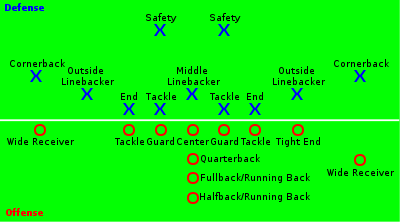
Offense
In American football, the offense is the term used to describe the team which has possession of the ball. It is their job to advance the ball towards the opponent's end zone to score points. Broadly, the eleven players of the offense are broken into two groups: the five offensive linemen, whose primary job is to block opponents and protect their quarterback, and the six backs and receivers whose primary job is to advance the ball either running with the ball or passing it. The backs and receivers are also commonly known as skill position players or as eligible receivers (or eligible ball carriers). Offensive linemen are not eligible to advance the ball past the line of scrimmage during a play.
The organization of the offense is strictly mandated by the rules of the sport; there must be at least seven players on the line of scrimmage and no more than four players (known collectively as "backs") behind it. The only players eligible to handle the ball during a normal play are the backs and the two players on the end of the line (the "ends"). The remaining players (known as "interior linemen") are "ineligible" to catch forward passes, so they usually only block. Within these strictures, however, creative coaches have developed a wide array of offensive formations to take advantage of different player skills and game situations.
The following positions are standard in nearly every game, though different teams will use different arrangements of them, dependent on their individual game plans.
Offensive (interior) line
The offensive line is primarily responsible for blocking the defensive line of the opposition, in order to protect their own quarterback. During normal play, offensive linemen do not handle the ball (aside from the snap from center), unless the ball is fumbled by a ball carrier, a pass is deflected, or when a player who is normally an offensive lineman takes a different position on the field. The offensive line consists of:
- Center (C)
- The center is the player who begins the play from scrimmage by snapping the ball to the quarterback. As the name suggests, the center usually plays in the middle of the offensive line, though some teams may employ an unbalanced line where the center is offset to one side. Like all offensive linemen, the center has the responsibility to block defensive players. The center often also has the responsibility to call out blocking assignments and make last second adjustments depending on the defensive alignment.
- Offensive guard (OG)
- Two guards line up directly on either side of the center. Like all interior linemen, their function is to block on both running and passing plays. On some plays, rather than blocking straight ahead, a guard will "pull", whereby the guard comes out of their position in line to lead block for a ball carrier, on plays known as "traps" (for inside runs), "sweeps" (for outside runs), and "screens" (for passing plays). In such cases, the guard is referred to as a "pulling guard".
- Offensive tackle (OT)
- Two tackles play outside of the guards. Their role is primarily to block on both running and passing plays. The area from one tackle to the other is an area of "close line play" in which blocks from behind, which are prohibited elsewhere on the field, are allowed. For a right-handed quarterback, the left tackle is charged with protecting the quarterback from being hit from behind (known as the "blind side"), and this is usually the most skilled player on the offensive line. Like a guard, the tackle may have to "pull", on a running play, when there is a tight end on their side. Tackles typically have a taller, longer build than interior offensive linemen, due to the need to keep separation from defensive linemen in pass blocking situations. They also tend to have quick footwork skills as they often engage against containing or rushing defensive ends.
Backs and receivers
The six backs and receivers are those that line up outside or behind the offensive line. There are four main positions in this set of players:
- Quarterback (QB)
- The quarterback is the player who receives the ball from the center to start the play. The most influential position on the offensive side, in that his team's progress down the field is dependant on his success, the quarterback is responsible for receiving the play from the coaches on the sideline and communicating the play to the other offensive players in the huddle. The quarterback may need to make late changes to the intended play at the line of scrimmage (known as an "audible"), depending on the defensive alignment. At the start of the play, the quarterback may be lined up in one of three positions. If they are positioned directly behind and in contact with the center and receives the ball via the direct hand-to-hand pass, they are said to be "under center". Alternatively, if they have lined up some distance behind the center, they are said to be either in "shotgun formation" or in "pistol formation" ('shotgun' is generally further back than 'pistol'). Upon receiving the ball from the center, the quarterback has three basic options to advance the ball: they may run the ball themselves, they may hand it to another eligible ball carrier to run with it, or they may execute a forward pass to a player further up the field.
- Running back (HB/FB)
- Running backs are players who line up behind the offensive line, in a position to receive the ball from the quarterback and execute a rushing play. Anywhere from one to three running backs may be utilized on a play (or none, a situation typically known as an "empty backfield"). Depending on where they line up, and what role they have, running backs come in several varieties. The "tailback" (or sometimes the "halfback") is often a team's primary ball carrier on rushing plays. They may also catch passes, often acting as a "check-down" or "safety valve" when all other receivers on a pass play are covered. The "fullback" is often larger and stronger than the tailback, and acts primarily as a blocker, though the fullback may also be used for catching passes or for rushing as a tailback does. Fullbacks often line up closer to the line of scrimmage than tailbacks do, so they may block for them. A "wing-back" or a "slot-back" is a term for a running back who lines up behind the line of scrimmage outside the tackle or tight end on the side where positioned. Slot-backs are usually only found in certain offensive alignments, such as the flexbone formation. A similar position, known as the "H-back", is actually considered a modification of the normal tight end position.
- Wide receiver (WR)
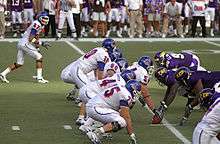
- Wide receivers are pass-catching specialists. Typically fast and tall, their main job is to run pass routes and get open (i.e. find a position with no near defender) for passes, although they are occasionally called on to block. Wide receivers generally line up split "wide" near the sidelines at the start of the play. Wide receivers, like running backs, come in different varieties depending on exactly where they line up. A wide receiver who is directly on the line of scrimmage is called a "split end", and is counted among the seven required players on the line of scrimmage. A wide receiver who lines up behind the line (and thus counts as one of the four backs) is called the "flanker". A wide receiver who lines up between the outermost wide receiver and the offensive line is said to be "in the slot" and is called the "slot receiver".
- Tight end (TE)
- Tight ends play on either side of, and directly next to, the tackles. Tight ends are considered hybrid players, something of a cross between a wide receiver and an offensive lineman. Because they play next to the other offensive linemen, they are very frequently called on to block, especially on running plays. However, because they are eligible receivers, they may also catch passes. The position known as the "H-back" is a tight end who lines up behind the line of scrimmage, and is thus counted as one of the four "backs", but otherwise their role is similar to that of other tight ends.
Depending on the style of offense the coaches have designed, the game situation, and the relative skill sets of the players, teams may run formations which contain any number of running backs, wide receivers, and tight ends, so long as the mandated "four backs and seven on the line" rule is followed. For many years, the standard set consisted of the quarterback, two running backs (a tailback/halfback and a fullback), two wide receivers (a flanker and a split end) and a tight end. Modern teams show a wide variety of formations, from a "full house" formation with three running backs, two tight ends, and no wide receivers, to "spread" formations featuring four or five wide receivers, sometimes without any running backs.
Defense
The defensive team or defense is the team that begins a play from scrimmage not in possession of the ball. The objective of the defensive team is to prevent the other team from scoring, and win possession of the ball for their side. The defense accomplishes this by forcing the offense to turn the ball over, either by: preventing them from achieving a first down and thus forcing them to punt, forcing the offense to fumble or throw an interception, or, more rarely, forcing a turnover on downs.
Unlike the offensive team, the rules of the sport do not restrict the defensive team into certain positions. A defensive player may line up anywhere on his side of the line of scrimmage and perform any legal action. Over time, however, defensive roles have become defined into three main sets of players, and several individual positions.
Defensive line
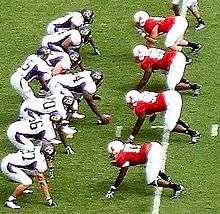
Like their offensive counterparts, defensive linemen (also called rushers) line up directly on the line of scrimmage, close to the ball. There are two positions usually considered part of the defensive line:
- Defensive tackle (DT);
- Sometimes called a "defensive guard", defensive tackles play at the center of the defensive line. Their function is to rush the passer and stop running plays directed at the middle of the line of scrimmage. The most interior defensive tackle who sometimes lines up directly across from the ball (and therefore is almost nose-to-nose with the offense's center) is often called a "nose tackle", alternately "nose guard" or "middle guard". The nose tackle is most common in the 3-4 defense. Most defensive sets have one or two defensive tackles. If one employs a second defensive tackle, sometimes called an "under tackle", they are usually a bit faster than the nose tackle.
- Defensive end (DE)
- The two defensive ends play next to the defensive tackles, at the edges of the defensive line. Their function is to attack the passer or stop offensive runs to the outer edges of the line of scrimmage (most often referred to as "containment"). The faster of the two is usually placed on the right side of the defensive line (quarterback's left) because that is a right-handed quarterback's blind side.
Often, a defensive lineman will have their hands on the ground, in a three- or four-point stance before the ball is snapped; this distinguishes their pre-snap stance from a linebacker, who begins in a two-point stance (i.e. without a hand touching the ground).
Linebackers
Linebackers play behind the defensive line and perform various duties depending on the situation, including rushing the passer, covering receivers, and defending against the run.
- Middle linebacker (MLB)
- Sometimes called the "inside linebacker" (especially in a 3-4 defense), and known colloquially as the "Mike" linebacker, the middle linebacker is often known as the "quarterback of the defense", as they are frequently the primary defensive play callers and must react to a wide variety of situations. Middle linebackers must be capable of stopping running backs who make it past the defensive line, covering pass plays over the middle, and rushing the quarterback on blitz plays.
- Outside linebacker (OLB)
- Outside linebackers are given different names depending on their role and the philosophy of the team. Some teams keep their outside linebackers on the same side of the field at all times. Some teams define them by their role; as playing either "strongside" (SLB) or "weakside" (WLB). The strongside, or "Sam", linebacker lines up on the same side as the offensive tight end and often is responsible for covering the tight end or running back on pass plays. The weakside, or "Will", linebacker lines up on the side of the offensive line without a tight end, and is often used to rush, or blitz the quarterback, or may need to cover a running back on pass plays.
Defensive backs
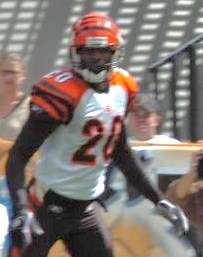
Defensive backs, also known as the "secondary", play either behind the linebackers or set to the outside, near the sidelines. Defensive backs are primarily used to defend against pass plays. Defensive backs also act as the last line of defense on running plays and need to be able to make open field tackles, especially when the ball carrier has gotten past the other defenders. A normal complement of defensive backs includes two cornerbacks and two safeties, though specialty defensive backs (nickelbacks and dime backs) can be brought in in place of linebackers and defensive linemen, when there is a need to cover additional pass receivers.
- Cornerback (CB)
- Cornerbacks attempt to prevent successful passes by either swatting the airborne ball away from the receiver or by catching the pass themselves. In rushing situations, their job is to contain the runner, either by directing them back to the middle of the field to be tackled, by tackling them themselves or by forcing them out of bounds.
- Safety (S)
- The safeties are the last line of defense (farthest from the line of scrimmage) and usually help the corners with deep-pass coverage. The strong safety (SS) is usually the larger and stronger of the two, providing extra protection against run plays by standing closer to the line of scrimmage, usually on the strong (tight end) side of the field. The free safety (FS) is usually the smaller and faster of the two, and is usually the deepest player on the defense, providing help on long pass plays.
- Nickelback and dimeback
- In certain formations, the defense may remove a linebacker or a defensive lineman to bring in extra pass coverage in the form of extra defensive backs. A formation with five defensive backs is often called a "nickel" formation, and the fifth (extra) defensive back is called a "nickelback" after the U.S. nickel coin, a five-cent piece. By extension, a formation with a sixth defensive back (dimeback) is called a "dime package", a 10-cent dime coin being two nickels (nickelbacks). Rarely, a team may employ seven or eight defensive backs on certain plays.
Defensive formations are often known by a numerical code indicating the number of players at each position. The two most common formations are the 3–4 defense and the 4–3 defense, where the first number refers to the number of defensive linemen, and the second number refers to the number of linebackers (the number of defensive backs can be inferred, since there must be eleven players on the field). Thus, a 3–4 defense consists of three defensive linemen (usually a nose tackle and two defensive ends), four linebackers, and four defensive backs (two cornerbacks, a strong safety, and a free safety)
Special teams
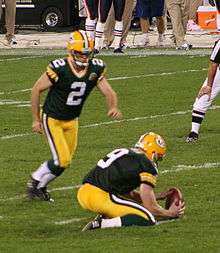
Special teams are units that are on the field during kicking plays. While many players who appear on offensive or defensive squads also play similar roles on special teams (offensive linemen to block, or defensive players to tackle) there are some specialist roles which are unique to the kicking game.
- Kicker (K)
- Also called a "placekicker", they handle kickoffs, extra points, and field goals. All three situations require the kicker to kick the ball off the ground, either from the hands of a holder or off of a tee. Some teams employ two kickers: one kicks extra points and field goals, and the other, known as a "kickoff specialist", handles kickoffs. Most, however, use a single kicker for both jobs, and rarely, the same player may also punt.
- Holder (H)
- Usually positioned 7–8 yards from the line of scrimmage, they hold the ball for the placekicker to kick. The holder is often a backup quarterback or a punter because of their "good hands", feel for the ball and experience taking snaps from the long snapper (center) during plays from scrimmage. A holder is occasionally used on kickoffs if the weather or field conditions repeatedly cause the ball to fall off the tee.
- Long snapper (LS)
- A specialized center who snaps the ball directly to the holder or punter. The long snapper is usually distinct from the regular center, as the ball often has to be snapped much farther back on kicking plays.
- Punter (P)
- The punter usually lines up 15 yards behind the line of scrimmage (this distance has to be shortened when it would result in being on or behind the end line). The punter, upon receiving the snap, drops the ball and kicks it from the air. This is usually done only on fourth down and is done to relinquish possession to the defensive team as far downfield as possible.
- Kickoff specialist (KOS)
- Kickoff specialists are exclusively used during kickoffs. Teams employ kickoff specialists if they feel neither their kicker nor punter is good enough at kicking off. Due to their specialized nature and the limited number of active roster spots, professional KOSs are rare.
- Kick returner (KR) and punt returner (PR)
- Returners are responsible for catching kicked balls (either on kickoffs or punts) and running the ball back. These are usually among the fastest players on a team. Teams may use the same player for both positions or may have a separate returner for punts and for kickoffs. Returners typically also play wide receiver or cornerback. Due to the relatively high likelihood of injury during kick returns, most professional teams will not regularly use their very best WRs or CBs as returners.
- Upback
- A blocking back who lines up approximately 1–3 yards behind the line of scrimmage in punting situations. Because the punter plays so far back, the back frequently makes the line calls and calls for the snap to be received by the punter. Their primary role is to act as the last line of defense for the punter. Upbacks may occasionally receive the snap instead of the punter on fake punts, and normally run the ball but may throw it.
- Gunner
- A player on kickoffs and punts who specializes in running down the field very quickly in an attempt to tackle the returner. Gunners usually line up near the sidelines where there will be fewer blockers which allows them to get down the field quickly.
- Jammer
- Jammers try to slow down gunners during punts or kickoffs so that the returners have more time.
See also
References
| Positions in American football and Canadian football | |||||||
|---|---|---|---|---|---|---|---|
| Offense (Skill position) | Defense | Special teams | |||||
| Linemen | Guard, Tackle, Center | Linemen | Tackle, End, Edge rusher | Kicking players | Placekicker, Punter, Kickoff specialist | ||
| Quarterback (Dual-threat, Game manager, System) | Linebacker | Snapping | Long snapper, Holder | ||||
| Backs | Halfback/Tailback (Triple-threat, Change of pace), Fullback, H-back, Wingback | Backs | Cornerback, Safety, Halfback, Nickelback, Dimeback | Returning | Punt returner, Kick returner, Jammer, Upman | ||
| Receivers | Wide receiver (Eligible), Tight end, Slotback, End | Tackling | Gunner, Upback, Utility | ||||
| Formations (List) — Nomenclature — Strategy | |||||||